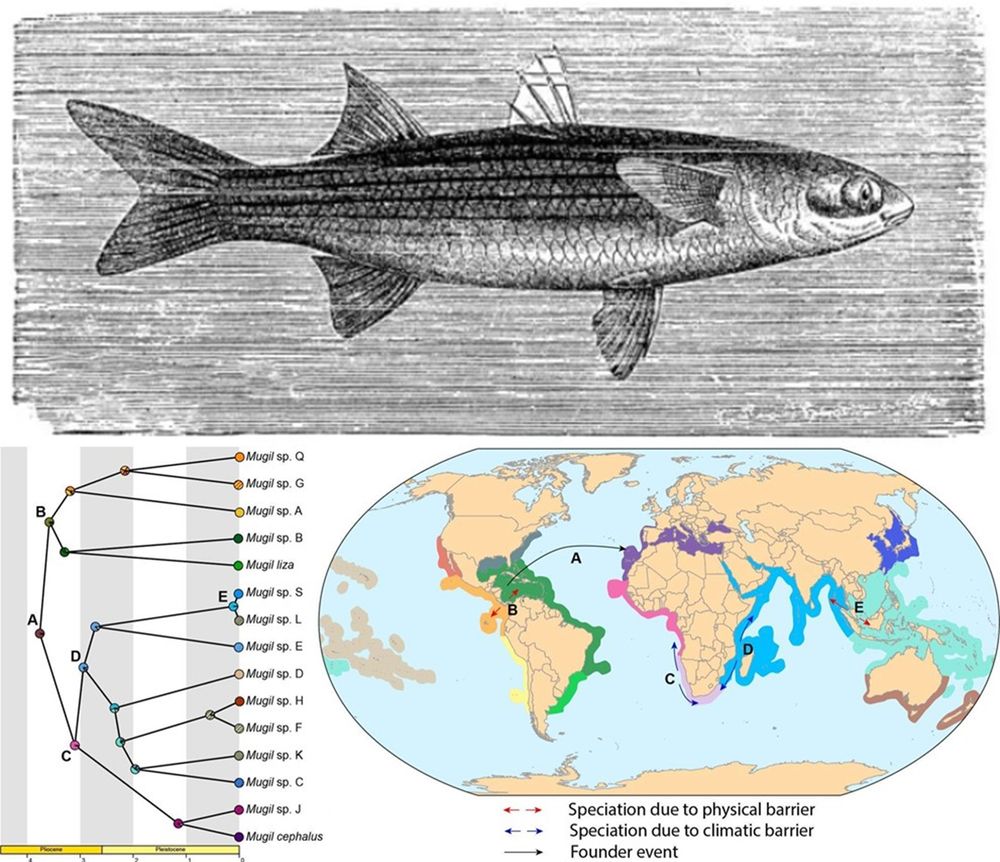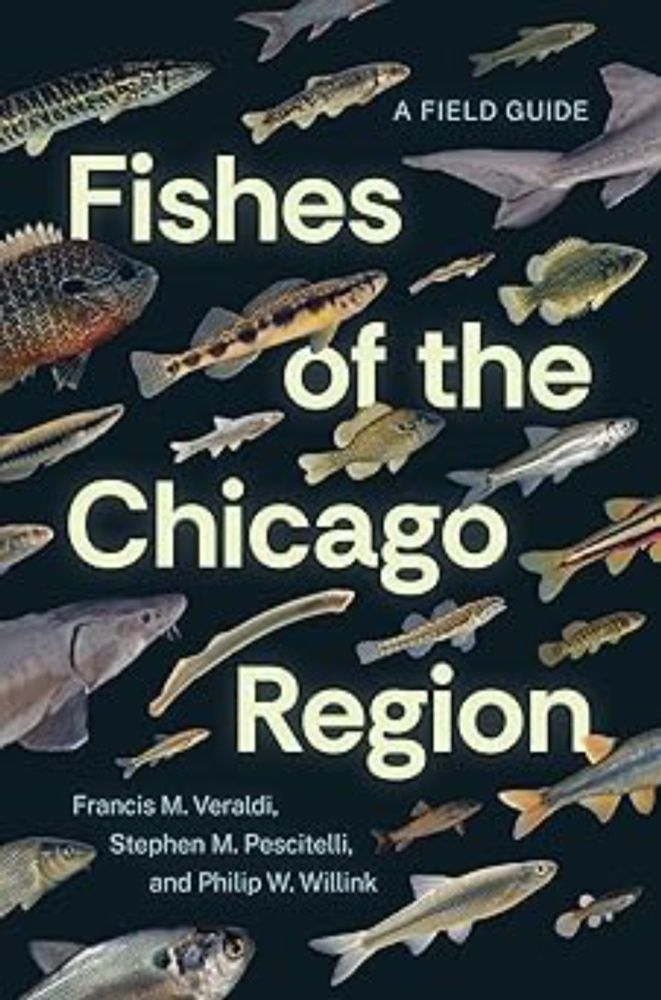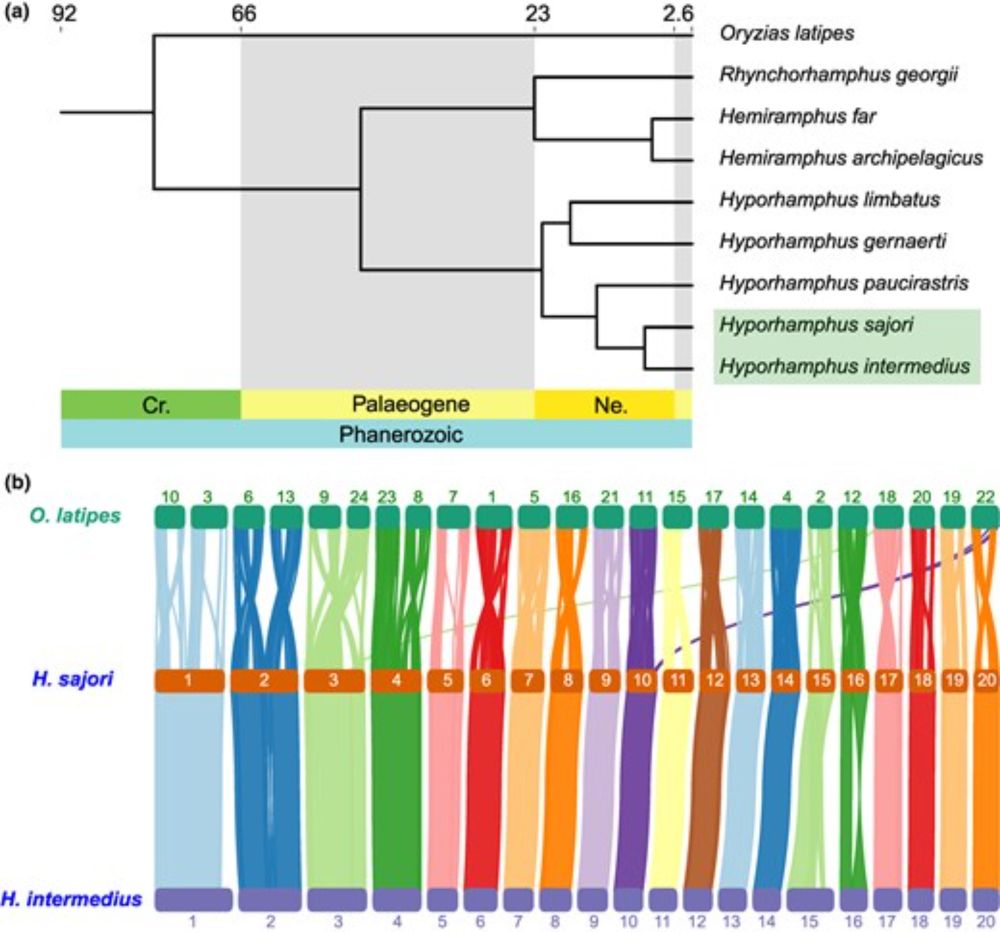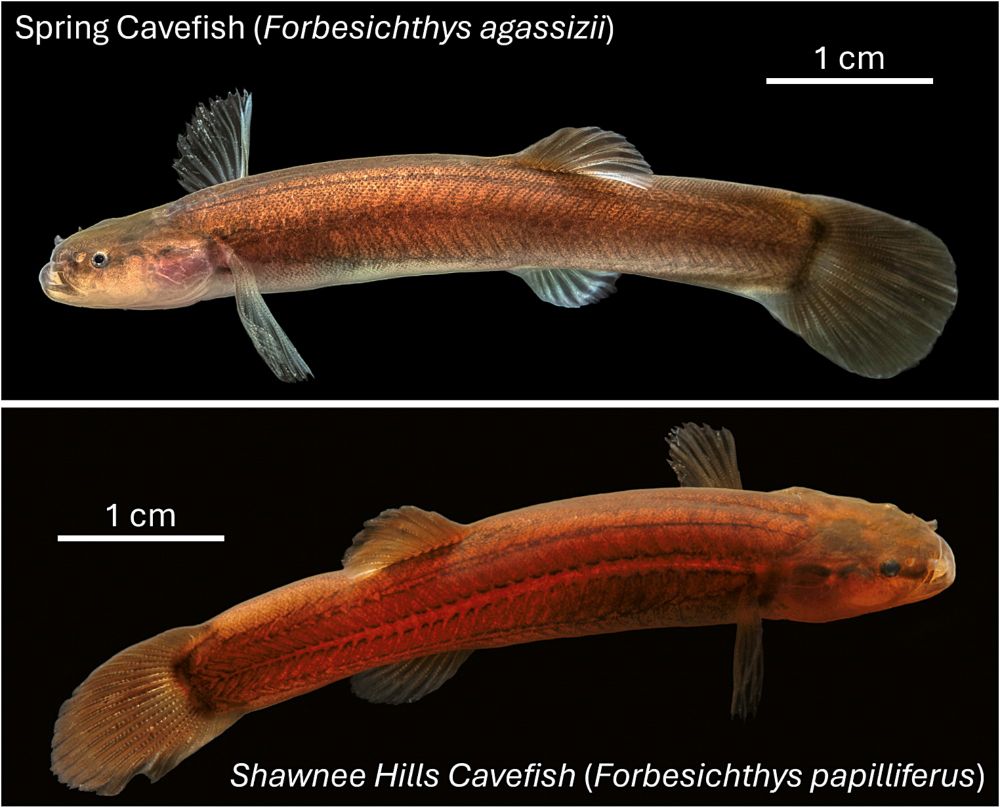
MBE | Temperature and Pressure Shaped the Evolution of Antifreeze Proteins in Polar and Deep Sea Zoarcoid Fishes
A graphic visualizing the finding by Bogan et al. that antifreeze protein (AFP) genes increased in copy number among shallow-water, polar species of Zoarcoidei fishes. Top left: Pholis gunnellus photographed by Chris Isaacs (CC-BY-NC). Top right: Cebidichthys violaceus photographed by Alex Heyman (CC0 1.0). Bottom left: Lycenchelys sp. photographed by Julien Savoie (CC BY 4.0). Bottom right: Lycodes sp. photographed by Julien Savoie (CC BY 4.0).
@snbogan.bsky.social @notothentoma.bsky.social @scotthotaling.bsky.social @paulbfrandsen.bsky.social et al. explore the evolution of type III antifreeze proteins in deep sea zoarcoid fishes.
🔗 doi.org/10.1093/molbev/msaf219
#evobio #molbio
21.10.2025 09:43 — 👍 15 🔁 7 💬 0 📌 1

Submit your ideas to the 100% Wisconsin Fish contest | Wisconsin Sea Grant
The contest is seeking creative ideas on how to use all parts of Great Lakes fish.
There's more to fish than the fillet, and we need your ideas on how to use it!
Submit your suggestions on how to use the whole fish to the 100% Wisconsin Fish contest for a chance to win a #GreatLakes prize pack.
www.seagrant.wisc.edu/news/submit-...
30.09.2025 13:34 — 👍 5 🔁 2 💬 0 📌 0

Non-anthropogenic cosmopolitan species ranges are scarce
Mugil cephalus, traditionally considered a (quasi)cosmopolitan diadromous fish species, is now shown to comprise some 15 different lineages deserving formal species description
www.sciencedirect.com/science/arti...
08.10.2025 08:45 — 👍 6 🔁 4 💬 0 📌 0

Unravelling the Effects of Ecology and Evolutionary History in the Phenotypic Convergence of Fishes
Abstract. Understanding the ecological drivers and limitations of adaptive convergence is a fundamental challenge. Here, we explore how adaptive convergenc
Super excited to share our new paper investigating convergence across planktivorous fishes and assessing the impact of ancestry and light environment led by Dr Jen Hodge @fishncurious.bsky.social and including most members of the lab past and present academic.oup.com/sysbio/advan...
14.05.2025 04:50 — 👍 55 🔁 21 💬 2 📌 1

Rapid Response Bridge Funding Program
In the face of recent abrupt shifts in federal funding for education research, including large-scale terminations of National Science Foundation (NSF) research grant awards, we have developed a rap...
**Rapid Response Bridge Funding Program** -- $25,000 grants earmarked for early-career researchers whose NSF-funded research on STEM and education has just been terminated.
www.spencer.org/grant_types/...
hub.jhu.edu/2025/04/28/j...
Thanks @lizneeley.bsky.social !
03.05.2025 15:22 — 👍 76 🔁 73 💬 0 📌 4

Fishes of the Chicago Region: A Field Guide
Buy Fishes of the Chicago Region: A Field Guide on Amazon.com ✓ FREE SHIPPING on qualified orders
New fish book alert! On this #FishFriday, "Fishes of the Chicago Region" was just released. Detailed info on species distributions & natural history observations for >150 species in SE Wisconsin, NE Illinois, northern Indiana, and SW Michigan. Check it out...
www.amazon.com/Fishes-Chica...
18.04.2025 16:52 — 👍 19 🔁 11 💬 0 📌 1
Congrats!!
14.04.2025 18:15 — 👍 1 🔁 0 💬 0 📌 0

Some microphagous fishes have a unique pocket-like throat structure, epibranchial organ (EBO), that helps gather tiny food particles. New study of 13 species reveals diverse EBO anatomy, weak phylogenetic ties & possible link to diet
Evans et al:
anatomypubs.onlinelibrary.wiley.com/doi/10.1002/...
03.04.2025 16:04 — 👍 22 🔁 15 💬 1 📌 3

(A) Likelihood of the top five best-fitting trees based on f2 statistics in 500 kb windows across the genome of the 6 bear populations studied (Ancient polar bear = APB, modern polar bears = PB, Alaskan brown bears = BB, Baranof and Chichagof brown bears = ABC-BC, European brown bear = EBB, American black bear = BLK). Tree A is the best fit and reflects the expected genetic relationships among the bear populations. Trees D and E are the fourth and fifth best-fitting trees reflecting hybridization from polar bears into brown bears (Tree D) and vice versa (Tree E). (B) Cases of hybridization among the best-fitting trees in (A) (trees D and E) and cases of incomplete lineage sorting (trees L and J) which fit worse than trees D and E.
Polar bears and their lower-latitude cousins—brown bears—have a complicated past! Genomes from a >115,000 year old polar bear and 65 modern bears reveal that although polar bears and brown bears began diverging >1 mya, they hybridized up until ~200 kya. #2025MMM doi.org/10.1073/pnas.2200016119
25.03.2025 00:40 — 👍 38 🔁 12 💬 3 📌 0

Fig. 1: The Chromosome number and Hidden State-dependent Speciation and Extinction (ChromoHiSSE) model. Panel (a) describes the event rates allowed in the model for both cladogenetic (upper) and anagenetic (lower) events. Panels (b) and (c) demonstrate those rates on a tree simulated under ChromoHiSSE. Branches that do not reach the present represent extinct, unsampled lineages. Panel (b) shows the anagenetic and cladogenetic changes in the hidden states, indicated by blue (i) vs orange (ii). Panel (c) shows the anagenetic and cladogenetic gains and losses of chromosomes, as well as speciation with no corresponding change in chromosome numbers. More red colors in (c) correspond to more chromosomes. The vertical blue and orange bars in (c) indicate clades in the blue (i) vs orange (ii) hidden states, displaying that chromosome number changes are less frequent in the blue hidden state than in the orange. The asterisk in (c) demarcates where a cladogenetic dysploidy event could appear as an anagenetic event because of unsampled lineages.
New study by @tribblelab.bsky.social @jimarcor.bsky.social @marcialescudero.bsky.social Michael May, Rosana Zenil-Ferguson and myself just out:
Introduces a novel HiSSE chromosome model and demonstrates the importance of chrom. evol. in #sedge diversity.
nph.onlinelibrary.wiley.com/doi/10.1111/...
26.12.2024 13:01 — 👍 75 🔁 24 💬 1 📌 1
No.
LG statistically tests specific landscape-based resistance/barrier models on gene flow at an individual/population level. PG is a clade based understanding of the species' range. LG can inform PG, but PG does not have to incorporate landscapes into the hypotheses that are being tested.
17.12.2024 05:21 — 👍 3 🔁 0 💬 0 📌 0
Let´s form a community of conservation geneticists here - I started with some people I know, but there are likely to be many more... I can happily add them to this list
go.bsky.app/VMqVSAi
02.11.2024 08:19 — 👍 84 🔁 53 💬 54 📌 8
For scientists interested in large lakes of the world. Contact us if you'd like to be added. Space still available.
15.11.2024 02:16 — 👍 88 🔁 32 💬 26 📌 6
Hi, could I be added? I'm working on fish conservation, population and landscape genetics.
30.11.2024 00:23 — 👍 1 🔁 0 💬 1 📌 0
My research involves a number of Great Lakes fishes and I would love to be added to the list.
29.11.2024 16:28 — 👍 0 🔁 0 💬 0 📌 0
go.bsky.app/LXwgsEZ
12.11.2024 15:52 — 👍 114 🔁 49 💬 48 📌 4
Genomics, Evolution, and More by @jlsteenwyk.bsky.social bsky.app/starter-pack...
15.11.2024 09:56 — 👍 5 🔁 1 💬 3 📌 0
Could I be added? Thanks!
25.11.2024 00:38 — 👍 1 🔁 0 💬 1 📌 0

Landmark scheme shown on the left side of a representative catfish. Paired landmarks (triangles) were digitized as two separate right and left landmarks, while medial landmarks (circles) were digitized once. Colors correspond to body regions analyzed for differential rates and modularity: purple = mouth (mouth anterior, mouth left and right, mouth posterior); red = snout (tip of snout, anterior nares, posterior nares); yellow = cranial region (anterior, medial, posterior, and lateral points of the eyes, dorsal and ventral extent of the opercle opening, posterio-medial supraoccipital); green = abdomen (dorsal-, pectoral-, and pelvic-fin origins, dorsal- and pectoral-fin tips); blue = tail (dorsal-fin insertion, cloaca, anal-fin origin and insertion, dorsal and ventral procurrent caudal-fin rays, end of vertebral column). Black dots indicate adipose-fin landmarks, which are absent in many species and not included in comparative analyses.
Pleased to share our new paper studying the adaptive diversification of body shape in catfishes of the superfamily Doradoidea and exploration of the evolution of modularity and integration.
DOI: doi.org/10.1643/i202...
50-day free access link: www.ichthyologyandherpetology.org/ihbjbd/bxi20...
19.11.2024 21:38 — 👍 41 🔁 13 💬 1 📌 1

a seahorse is swimming in a monterey bay aquarium
ALT: a seahorse is swimming in a monterey bay aquarium
Check out our new paper, led by @asantaquiteria.bsky.social ! Awesome fish diversity and #evolution, phylogenomics and evolutionary patterns of seahorses, goatfishes, dragonets, flying gurnards (Syngnatharia) across oceans.
🐟🧪🦑🌎
www.journals.uchicago.edu/doi/10.1086/...
20.11.2024 23:52 — 👍 75 🔁 25 💬 2 📌 1
Thank you!
14.11.2024 17:03 — 👍 1 🔁 0 💬 0 📌 0
Despite having recently worked on a herpetology project, could I be added?
14.11.2024 16:46 — 👍 1 🔁 0 💬 1 📌 0
scholar.google.com/citations?us...
10.01.2024 04:34 — 👍 0 🔁 0 💬 1 📌 0
Posdoctoral researcher 🔥| Forest Ecologist | Fire Ecology | Plant Flammability | Ecological Restoration | Seed Germination | Invasive Species
Professor of Genetics at U of Leicester. Genome structural variation.
"Anyone with gumption and a sharp mind will take the measure of two things: what's said and what's done." Views my own.
Functional morphology and physiological ecology of fishes. Postdoc | she/her
Understanding bats through research. Host-Pathogen responses/Comparative Biology/Immunology. opinions my own. A. Prof @ZJE_institute Zhejiang University
Professor of marine biology at James Cook University, Australia - #biodiversity #coralreefs #fish #sharks #stress #physiology #evolution #conservation #climatechange #physioshark #TEDx #LGBTQ #STEM
Professor of Evolutionary Biology at Louisiana State University.
Phylogenomics, Molecular Evolution, Evolutionary History, Statistics, Computational Biology
Indiana and Texas Alum
Professor. Sociologist. NYTimes Opinion Columnist. Books: THICK, LowerEd. Forthcoming: 1)Black Mothering & Daughtering and 2)Mama Bears.
Beliefs: C.R.E.A.M. + the internet ruined everything good + bring back shame.
“I’m just here so I don’t get fined.”
Marine Ecologist, Deep-Sea Explorer, Climate Change Researcher, Science Communicator, Ed @deepseanews
Studying why and how behavior evolves, from mosquitoes to mole-rats | Postdoc/Leon Levy Scholar @Columbia working with Ishmail Abdus-Saboor | PhD @Princeton with Lindy McBride | 麻布/東大 alum 🇯🇵 | yukihaba.github.io
Senior Research Scientist at Field Museum || Lecturer @saic-edu.bsky.social || Evolutionary biologist interested in macroevolution, symbiosis, fungi and geobiology. Posts my own. https://mpnelsen.com/
evolutionary/population/community ecologist
associate professor at NC State
Interests: 🧉🌱🏃🏾♀️🐦⬛🎶🏔️🏜️
www.seemasheth.weebly.com
she/her
views my own
UMich professor who studies resistance and persistence (in plants)
Follow me to receive notifications via DM whenever you're added to a starter pack, block list, feed or when someone blocks your account.
Follow @unsub.blocks.listifications.app to opt out of direct block notifications.
Lecturer (Maître de Conférences HDR) in Evolutionary biology and Ecology at the University of Perpignan Via Domitia. Associate Editor at @jevbio.bsky.social. Passionate photographer.
#speciation #biogeography #hybridization #evolution 🪶 🐠 🌸
The official "Resistance" team of U.S. National Park Service. Our website: www.ourparks.org
Botanist, public speaker, and musician
Conservation Ecology, Modeling, Mathematical Optimization, Conservation Planning, Spatial Analysis...
Landscape Scientist with TNC
~ Opinions my own ~
Plant systematist, herbarium director, naturalist, in the Chicago suburbs; posts reflect my views, not my employer's.
Recent book: Oak Origins: From Acorns to Species & the Tree of Life
https://press.uchicago.edu/ucp/books/book/chicago/O/bo236998258.html
UC-AFT Lecturer in the Masters in Conservation and Restoration Science Program at UC Irvine and UAW 4811 Project Scientist with UCI Environmental Collaboratory. Marine ecology, RStats, and conservation biology! https://orcid.org/0000-0003-0437-5937
Antarctic wildlife ecologist, Rutherford Discovery Fellow, Assoc Prof UCNZ, speaker, children’s book author
@natgeo Secrets of the Penguins
drmichellelarue.com
















